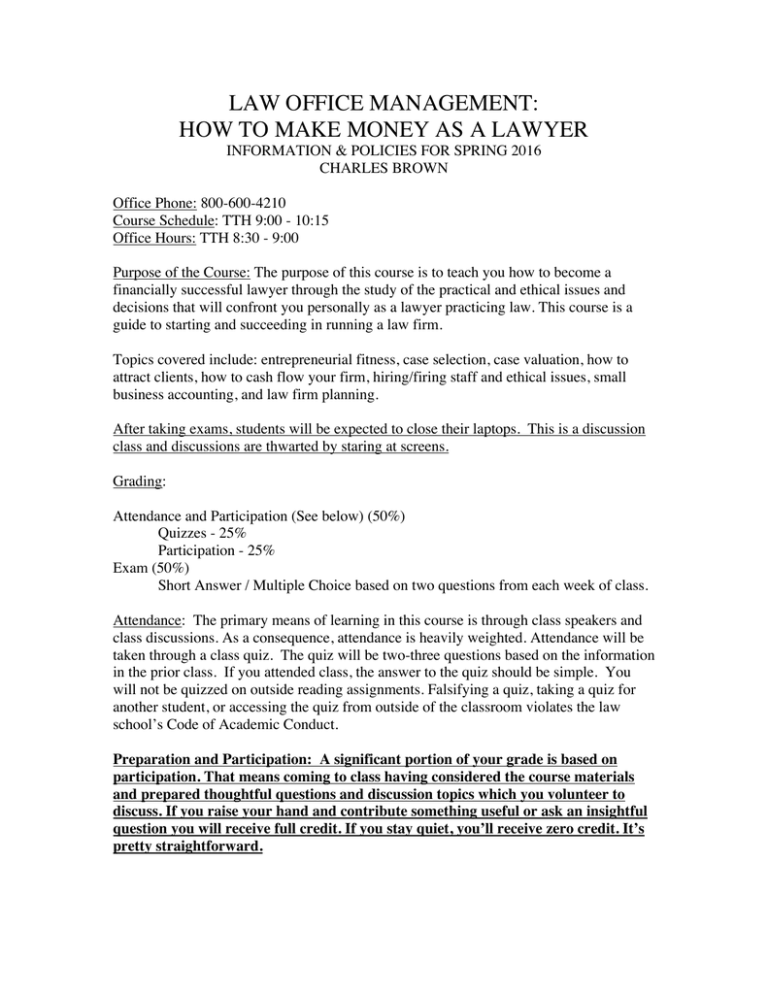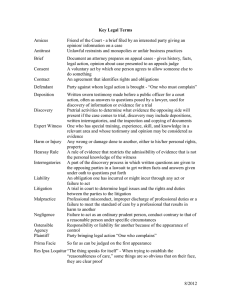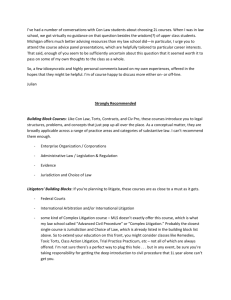LAW OFFICE MANAGEMENT: HOW TO MAKE MONEY AS A LAWYER
advertisement

LAW OFFICE MANAGEMENT: HOW TO MAKE MONEY AS A LAWYER INFORMATION & POLICIES FOR SPRING 2016 CHARLES BROWN Office Phone: 800-600-4210 Course Schedule: TTH 9:00 - 10:15 Office Hours: TTH 8:30 - 9:00 Purpose of the Course: The purpose of this course is to teach you how to become a financially successful lawyer through the study of the practical and ethical issues and decisions that will confront you personally as a lawyer practicing law. This course is a guide to starting and succeeding in running a law firm. Topics covered include: entrepreneurial fitness, case selection, case valuation, how to attract clients, how to cash flow your firm, hiring/firing staff and ethical issues, small business accounting, and law firm planning. After taking exams, students will be expected to close their laptops. This is a discussion class and discussions are thwarted by staring at screens. Grading: Attendance and Participation (See below) (50%) Quizzes - 25% Participation - 25% Exam (50%) Short Answer / Multiple Choice based on two questions from each week of class. Attendance: The primary means of learning in this course is through class speakers and class discussions. As a consequence, attendance is heavily weighted. Attendance will be taken through a class quiz. The quiz will be two-three questions based on the information in the prior class. If you attended class, the answer to the quiz should be simple. You will not be quizzed on outside reading assignments. Falsifying a quiz, taking a quiz for another student, or accessing the quiz from outside of the classroom violates the law school’s Code of Academic Conduct. Preparation and Participation: A significant portion of your grade is based on participation. That means coming to class having considered the course materials and prepared thoughtful questions and discussion topics which you volunteer to discuss. If you raise your hand and contribute something useful or ask an insightful question you will receive full credit. If you stay quiet, you’ll receive zero credit. It’s pretty straightforward. Better Late Than Never: Try to be on time to class. But if you arrive late, come to class anyway. Required Reading: You Can’t Teach Hungry, John Morgan During the class, additional articles and books will be suggested as reading material. Class Topics: 1. Introduction a. My Background b. Class Structure c. Goals d. My Promise to You i. Understand How Money is Made by Law Firms ii. Have a Foundation for Evaluating Whether Owning a Firm Works for You iii. Be Better Equipped to Survive and Thrive as a Lawyer 2. Society and Money a. Thoughts and Quotes About Money b. What is rich? c. What is success? d. Are rich people different? i. How Rich People Think by Steve Siebold ii. Rich Dad Poor Dad 3. What is a law practice? a. Requirements b. Goals c. Revenue d. Expenses 4. Intro to the Business of Being a Lawyer in Texas a. Why most lawyers suck at business. i. Professional vs. Professional Business ii. Ego Driven iii. You can’t work in and on your firm. b. Different Methods of Making Money i. Hourly ii. Contingent iii. Retainer c. Types of Practices i. Civil Tort Litigation 1. Plaintiffs 2. Defense ii. Business Litigation iii. Business Transactional iv. Family Law v. Criminal vi. Government 5. How Practice Types Shape Practices and Staffing a. Priorities of Outcome b. Funding Requirements c. Goals of Litigation d. Lawyer Fears / Concerns e. Trial Strategy f. Client Fears / Concerns 6. How Billing Structure and Business Shape Practices and Staffing a. Priorities of Outcome b. Funding Requirements c. Goals of Litigation d. Lawyer Fears / Concerns e. Trial Strategy f. Client Fears / Concerns 7. How to be an effective associate a. Hourly Billing Associate vs. Contingency Associate b. What Your Boss Won’t / Can’t Tell You 8. Advertising & Marketing a. Marketing Theory – What are you trying to do? b. Determining Cost Effective Advertising i. Ad costs ii. Tracking c. Advertising Review Process d. Display vs. User Intent e. Types: i. Radio ii. TV iii. Phonebook iv. Referrals v. Internet vi. Networking vii. Referrals & Referral Fees 9. Law Firm Websites a. Who to Hire, How much to Pay b. Rankings & SEO / Local / Adwords, AdCenter, Retargeting 10. Closing and Signing Clients a. Client Interviews b. Getting real facts c. WHEN / Damages / Who / What (in order) d. Answering Client Questions e. Signing Up a Client f. Setting Expectations g. Puffery h. When / Where 11. Client Contracts a. Necessary Elements of the Contract b. Other Client Documents 12. Handling Plaintiff s Cases a. Plaintiff’s Case Selection b. What gives a case value? c. What to look for in the records d. Niche v. Broad Practice 13. Initial Handling of Plaintiff’s Cases a. Calendaring and Limitations b. Getting Records and Authorizations c. Preparing expert reports, petitions, discovery, and notice letters. d. What Depositions to Take, What to Let Go e. Expert Witnesses, Who, How Much, How Many Needed 14. Mediation a. How Mediations Work b. Valuing Cases & Effective Negotiation Strategy 15. Resolving Cases a. Obligations to Your Client b. Resolve Cases Fast vs. Maximize Value c. What Causes a Settlement. d. Effective mediation strategies e. Methods of increasing case value f. Stowers g. Third-Party Liens 16. Professional Malpractice a. Common Ways Attorneys Get Sued and How to Avoid Them b. Professional Malpractice Insurance -- How to not get sued. 17. Projecting Startup Costs of a Plaintiff’s Firm a. Staffing b. Staff Structures c. Hiring d. Payroll e. Liability f. Real Estate g. Leases h. Funding i. Options j. Lending Environment Today 18. Running a Practice Cheaply a. Outside Vendors vs. In-House b. What You Can / Can’t Cut Corners On 19. Small Business Accounting, Projections, and Reporting a. Small Business Accounting b. Creating Projections c. Reporting d. Evaluating feasibility i. Cash flow ii. Profitability iii. Planning from Numbers 20. A Plaintiff’s Medical Malpractice Practice a. The business of a Plaintiff’s Medical Malpractice Practice. b. Case Selection c. Specialist vs. Generalist d. Staff Structure e. Time breakdown in handling cases f. Cash flow Analysis 21. A Plaintiff’s Mass Torts Practice a. Decision to start, and their experience starting a practice. b. Costs c. Case Selection d. Case Sources e. Practice Structure f. Cash flow g. Future Plans & What Looking For In Associates 22. An Hourly Billing Consumer Practice a. Startup of a Criminal Defense Practice b. Niche Selection c. Advertising d. Cash flow Analysis e. Capital Requirements f. Firm Staffing Structure 23. Business Litigation Practice a. Niche Selection b. Advertising c. Cash flow Analysis d. Capital Requirements e. Firm Staffing Structure 24. In-House Counsel a. Overview of Position: i. Who you answer to? ii. What defines success? iii. How does one enter the field iv. Benefits and downsides of in-house position b. Dealing with Outside Counsel, Plaintiff’s and Defense c. Plaintiffs d. What approach do you take, why? e. What alternative approaches do in-house counsel take? f. What role does litigation play in your practice g. When do you decide to hire for litigation? h. How do you decide who to hire? i. What makes you happy / unhappy with outside counsel? 25. A Retainer-Based Family Law Practice a. Starting a Family Law Practice b. Obtaining & Retaining Clients c. Financials & Cash flow d. Profit-Centers in the Practice e. Billing Strategy 26. A Defense Practice a. Running a defense firm b. Obtaining & Retaining Clients c. Financials & Cash flow d. Profit-Centers in the Practice e. Billing Strategy 27. What contingency fee lawyers prioritize a. Case Selection b. Advertising c. Cashflow Analysis d. Capital Requirements e. Firm Staffing Structure


![[2012] NZEmpC 75 Fuqiang Yu v Xin Li and Symbol Spreading Ltd](http://s3.studylib.net/store/data/008200032_1-14a831fd0b1654b1f76517c466dafbe5-300x300.png)

